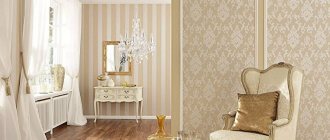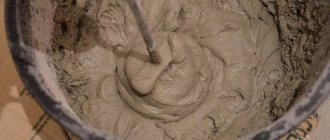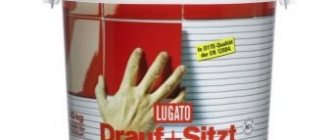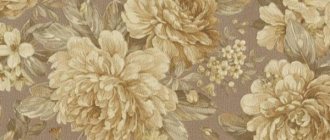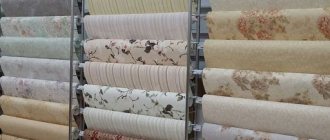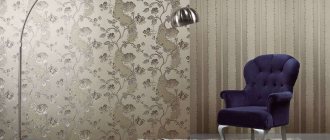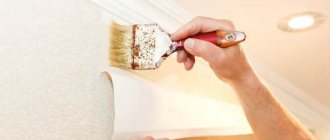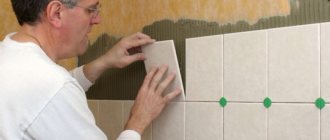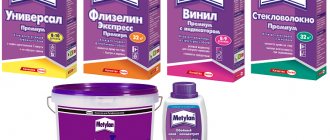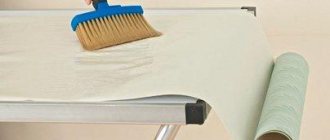The consumption of wallpaper glue per 1 m2 is usually indicated on the packaging of the purchased composition, but practice shows that this consumption is not always accurate and during work, as a rule, the glue runs out at the most inopportune moment.
It is also not uncommon for cases when, after completing wallpapering of the areas planned for renovation, a large amount of unclaimed adhesive remains, which has to be thrown away.
Choosing wallpaper glue
Before buying glue, you need to read the information about the purchased wallpaper on its label.
Glue can be selected according to its constituent elements:
- For paper wallpaper - smooth and embossed, light single-layer, ceiling, corrugated, etc. When choosing this type, rely on the price of the product - it is better to choose a mixture at an average price. If you buy cheap material, there is a chance that it will soak and ruin your wallpaper;
- For vinyl and non-woven wallpaper - the favorite type of wallpaper for many households, because there is no need to apply glue to the wallpaper, just spread it on the walls - accordingly, you can do such work in splendid isolation. Methylulose is added to the main components of this type. The most popular glue is diluted with water. The main thing is to follow the proportions indicated on the packaging;
- Universal adhesive - intended for all types of wallpaper. Experts are divided on this type of adhesive - some believe that this is an ideal option for gluing, others insist that it is better to use the material based on the type of wallpaper purchased.
And only you must decide what is best for yourself by reading the instructions of different types.
What does consumption depend on?
The average figures are indicated on the pack, but when the work is completed, the costs may be more or less.
Factors affecting wallpaper glue consumption:
- condition of the plaster;
- evenness and smoothness of the surface;
- type of fixing composition;
- type of wallpaper material;
- correct calculation of the area of the room;
- the presence of “problem” areas - bends, corners, etc.
Dependence on the materials used
If the surface is smooth, then the amount of composition used will correspond to the norm specified by the manufacturer. Walls that have visible defects or unevenness must be prepared in advance, otherwise the consumption will double. Costs also depend on the texture of the surface and its ability to absorb. Walls that instantly absorb liquid are pre-coated with a primer.
Working with fiberboard and wood reduces the consumption of fixing mass. The slab absorbs the solution well, so it is applied in a thin layer. The required volume depends on the density of the wood. Pre-treatment of the surface with a primer helps to avoid losses.
Stone and concrete walls, too smooth plaster do not absorb liquid well, so the adhesive mass slowly penetrates into the base. It is necessary to increase the amount of fixative used or prime the walls with it.
Interesting video on the topic:
Dependence on the brand of glue and type of wallpaper
The cost of the product depends on the characteristics of the paste and the finishing material. Approximate standards for some brands are shown in the table.
| Glue brand | Pack weight, g | Type of wallpaper | Application area for 1 pack, rolls or m2 | Water consumption, l |
| Axton | 180 | Paper | 5 rub. | 5 |
| 180 | Vinyl | 5 rub. | 4 | |
| 280 | Non-woven | 6 rub. or 30 m2 | 5 | |
| 500 | Glass wallpaper | 6 rub. or 25 m2 | 4,5 | |
| 450 | Heavy | 10 rub. or 50 m2 | 7 | |
| Cleo Ultra 25 | 250 | Non-woven | 30–40 m2 | 5 |
| Vinyl | 30–40 m2 | 5 | ||
| Glass wallpaper | 18–25 m2 | 3,5 | ||
| Special wallpaper | 30–40 m2 | 5 | ||
| Cleo Ultra 50 | 500 | Heavy | 60–80 m2 | 10 |
| Glass wallpaper | 35–50 m2 | 7,5 | ||
| Cleo Optima | 100 | Paper single-layer | 4–5 r. or 20–25 m2 | 3,5 |
| Paper multilayer | 3–4 r. or 15–20 m2 | 3 | ||
| Quelyd | 300 | Non-woven | 35–40 m2 | 4,5–5 |
| 300 | Vinyl, textile | 5–6 r. | 4–5 | |
| Metylan Station Wagon | 250 | All types of paper | 8–10 r. or 42–48 m2 | 7,5 |
| Moment | 190 | Paper single-layer | 6–9 r. | 6,7 |
Vinyl, interlining, fabric sheets are fixed with a fixative containing 50% PVA. It firmly connects finishing materials to the surface. The composition ensures high-quality performance of work in damp and cold rooms, as well as on poorly prepared walls.
Why calculate wallpaper glue?
Manufacturers usually indicate their consumption on the product packaging. But there are times when this information is unreliable, and you are left with unused material or, on the contrary, there is not enough material to complete the work.
Not a very pleasant situation, requiring additional actions and distracting from work! The fact is that manufacturers indicate glue consumption, taking into account “ideal” conditions and surface, which is rarely seen in reality.
It is better to spend a little time on correct calculations than to think later about where to put the material that is not useful or to go to buy more missing material. And according to your calculations, you can safely buy the amount that will cover the planned area.
This approach will allow you to significantly save your budget, especially if you are renovating several rooms or the entire apartment.
The following recommendations will help you minimize costs:
- If you decide to glue vinyl wallpaper, you do not need to apply glue to it; just having the glue on the wall is enough;
- Pay attention to all non-smooth surfaces - if they are not leveled, due to their roughness they will consume much more material; Therefore, not very smooth walls need to be primed first;
- In order for the wallpaper to stick well on difficult, “capricious” surfaces, you need to dilute a thicker mixture, then the wallpaper will stick the first time;
- To stick thick, expensive wallpaper, it is advisable to purchase a ready-made liquid, which will undoubtedly cope with gluing non-standard wallpaper. But, of course, such a product will cost you more than other simpler options;
Dependence of glue consumption on its brand and type of wallpaper
Today on the construction market there is a great variety of adhesive compositions designed for a wide variety of types of wallpaper, taking into account the surfaces on which these wallpapers can be glued.
The glue consumption, depending on its name, types of wallpaper and dilution methods, can also be determined from the table:
| Name | Weight | Type of wallpaper | Square | Water consumption |
| Glue for all types of paper wallpaper | 180 g | Paper | 5 rolls | 5 liters |
| Vinyl wallpaper adhesive | 180 g | Vinyl | 4-5 rolls | 4 liters |
| Cleo ultra | 250 g | Fiberglass Nonwoven Vinyl Special Wallpaper Priming | 18-25 m2 30-40 m2 30-40 m2 30-40 m2 55 m2 | 3.5 liters 5 liters 5 liters 5 liters 6.5 liters |
| Cleo smart | 200 g | Light vinyl wallpaper Heavy vinyl wallpaper | 7-9 rolls 35-35 m2 5-7 rolls 25-35 m2 | 7.5 liters 6 liters |
For gluing paper wallpaper, ordinary wallpaper glue is used, in which starch or its substitute methylcellulose is used as a base. All other wallpapers are glued with specialized glue, the consumption of which is determined separately for each specific case. To learn how to choose glue, watch this video:
Vinyl, non-woven and fabric wallpapers are glued with glue, which should contain a high content of PVC and PVA emulsions up to 50%. The same glue is used for gluing glass wallpaper.
You will also need specialized glue to apply wallpaper in rooms with low temperatures, high humidity, drafts and other possibly difficult conditions. The glue consumption for this wallpaper per 1 m2 is also determined individually.
Source
Instructions for using wallpaper glue
In order not to make a mistake in calculations for the further use of glue, take into account the type of wallpaper purchased, the glue and calculate the area that needs wallpapering.
Important criteria are taken into account here:
- Before you start gluing, you need to “prepare the ground”;
- A plastered wall needs careful puttying and priming, otherwise much more glue will be used or not enough at all;
- You don’t need to put a lot of effort into calculating the required amount of plaster; you can use a calculator;
- Do not lose sight of the type of wallpaper you have chosen - you may need a certain type of glue;
- From the calculated area, do not forget to subtract the area of doors and windows;
- The least amount of glue is consumed when working with a smooth surface.
Online wallpaper calculator
Calculating wallpaper using an online calculator: calculating the number of rolls and their cost for a room - taking into account doors, windows, repeat, overlay.
The wallpaper calculator allows you to calculate the amount of wallpaper when decorating the entire room and certain walls separately, which can be useful in non-standard rooms with 5 or more walls or in cases where you plan to use different types of textures. The program allows you to take into account the repetition of the pattern (rapport), lateral overlap, the presence of door and window openings, correctly calculating the application surface area, which in turn allows you to optimize the consumption of wallpaper and wallpaper glue, as well as eliminate overpayment for unnecessary materials. In the appendix, you can familiarize yourself with the standard values for glue consumption - you can immediately “estimate” how much wallpaper glue you will need. You might be interested in the wallpaper glue consumption calculator.
Related regulatory documents:
Calculate the amount of glue correctly
After clarifying all the information, you can begin your calculations.
Follow these instructions:
- Calculate the area of all rooms in the house where you are going to renovate. The wall area is calculated by multiplying the ceiling height by the length of the wall itself. Having added the resulting numbers, you need to multiply them by two and subtract the area of doors and windows from this value;
- Now start calculating the required amount of wallpaper to paste on a specific section of the walls, taking into account the width of the roll. The length of the wallpaper is almost the same - 10.5 meters. As a result, we calculate the amount of wallpaper using the following formula: divide the folded area of all walls by the product of the length and width of the roll in meters;
- After this, you can look at the glue pack itself - there are detailed instructions that will allow you to clearly determine the required volume of consumption. Most often, there is a good description of how much material is consumed for a certain number of rolls - this way you can find out how many packs of glue to purchase.
For vinyl and non-woven wallpaper, the calculation is somewhat different, but for them there are special adhesive compositions on sale with fairly detailed paper information on application.
When diluting glue with water, follow the manufacturer's exact recommendations. Everyone knows that an open pack of glue does not have a long shelf life, so most often the leftovers go to a landfill. Although if you suddenly miscalculated the material, you can agree with the seller to return the unused product.
Instructions
In order for our calculator to be able to calculate the amount of wallpaper per room, you need to select a calculation option (by the area of the apartment or the area of individual walls), and then enter the room parameters as accurately as possible
For the first option:
For the second option:
As an additional condition, you can use the “Windows” and “Doors” blocks. With their help, when calculating wallpaper, the areas that will be occupied by the corresponding structures are taken into account and/or excluded.
The tool equally correctly calculates wallpaper in situations where the canvas partially or completely falls into the opening.
Also, if you have other places where wallpaper is not expected, for example, an interior window between the living room and kitchen or a furniture set, you can use the “Windows” and “Doors” fields for these purposes as well.
Then you need to fill out the characteristics related to the wallpaper itself:
Let's look at some steps in more detail
Rapport is a repeating part of a pattern, or otherwise, a parameter that shows the cyclical repetition of a pattern in height and/or width. The value is indicated directly on the roll and measured in centimeters. If you have wallpaper without a pattern, then enter “0” in the field.
Leveling margin (trimming) is an additional value for each unfolding of the fabric for cutting in case of horizontal unevenness of ceilings/floors. The optimal size is 5-15 cm.
Side overlay - implies partial overlap of one roll with another, the so-called “overlapping” gluing technology.
Move the pattern – shift the pattern by 0.5 repeats. In fact, it leads to an increase in wallpaper consumption.
Use the convenient KALK.PRO wallpaper calculator and you will no longer have questions - how to calculate the amount of wallpaper per room?
Table for calculating wallpaper by room area
In some cases, when calculating wallpaper for a room, it is more convenient for the user to use standard tables to obtain an approximate result. We offer you an option that involves calculation based on the area and height of the room.
Source
Photos of the best wallpaper glue manufacturers
Adhesive for linoleum: consumption per 1 m2, how long it takes to dry
Linoleum is a floor covering that is distinguished by its durability, wear resistance and low price. Today it is actively used when arranging floors in houses, apartments, hospitals, and kindergartens. In order for the floor covering to retain its attractive appearance for a long time and not be subject to deformation, it is necessary to select the correct glue and calculate the consumption during its installation. The quality of the installed material will depend on the quality of the adhesive composition.
How to dilute and apply
To dilute glue produced in dry form, you will need a spacious container (basin, bucket), a wooden spatula and water. Everything must be clean to prevent solid particles from getting into the glue. If dirt gets on the wall or wallpaper during application, it will be impossible to remove it from under the canvas. This is where a bulge or breakout most often forms.
The liquid for diluting the glue is clean, free of sand and foreign inclusions. The water temperature should be between 23-25 degrees. This is a favorable indicator for dissolving the dry mixture.
When mixing the glue with a mixer, it is allowed to use warmer water (no more than 35 degrees).
The proportions of glue and water are indicated on the product label. Do not violate the standards recommended by the manufacturer. Otherwise, working with a mixture that is too thick will be problematic. The liquid composition will not provide proper adhesion of the wallpaper to the wall. The glue must match the type of wallpaper with which you plan to cover the room.
How to properly prepare wallpaper glue. Methods for wallpapering
Procedure for diluting glue:
- fill the container with water (the amount should be proportional to the glue used);
- add dry glue portionwise to the liquid with continuous stirring; this procedure is performed quickly so that lumps do not have time to form;
- after receiving a homogeneous substance, you need to let it brew for the time indicated on the label (from 3 to 10 minutes);
- Stir the glue vigorously again, making sure there are no lumps or foreign inclusions.
The composition is ready for use. If you follow the instructions, you get a consistency reminiscent of medium-thick sour cream.
Builder tips
Some tips from the professionals:
- To more effectively clean the wall, you can wash it with bleach and then rinse with plain clean water.
- Wash and soak all tools only in warm water, this will extend their service life.
- Excess glue should be removed with a damp and clean sponge.
- Completely exclude the admission of fresh air into the room in which repairs are being carried out. Drafts can instantly ruin all your work.
Special non-woven adhesive Quelyd
